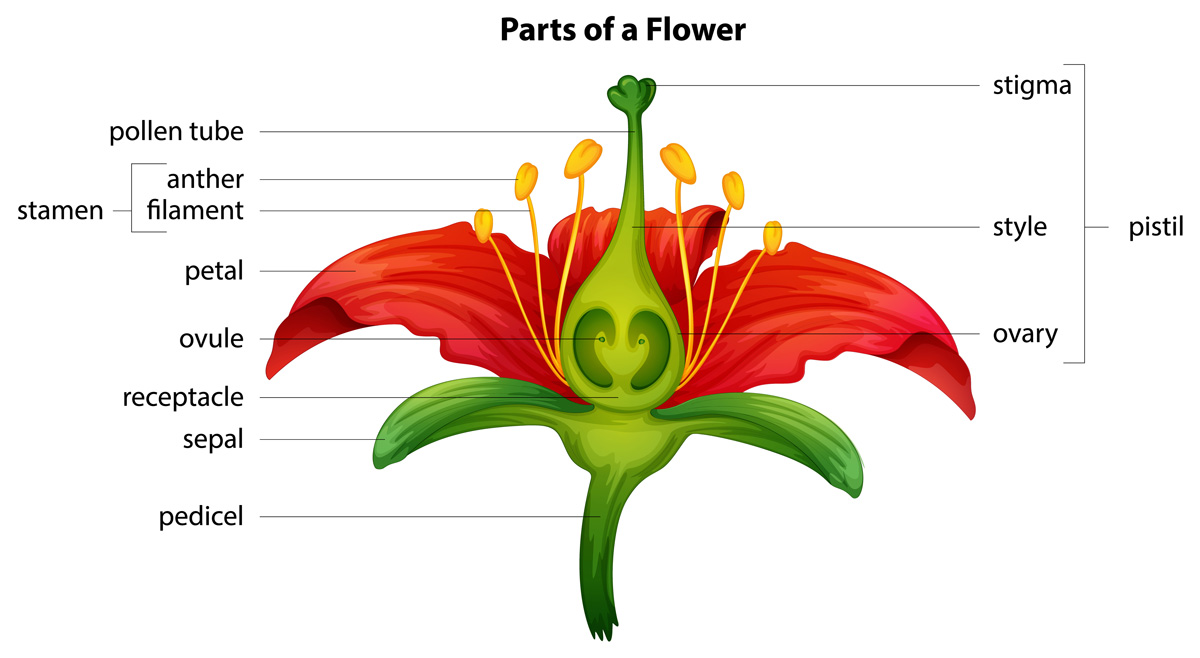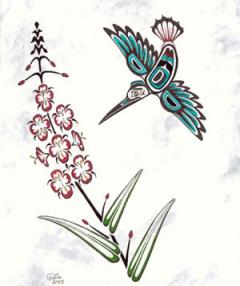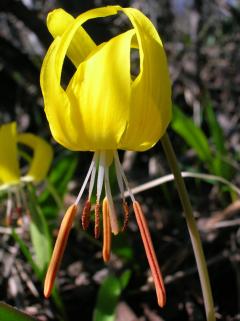Pollination is the act of transferring pollen grains from the male anther of a flower to the female stigma. The goal of every living organism, including plants, is to create offspring for the next generation. One of the ways that plants can produce offspring is by making seeds. Seeds contain the genetic information to produce a new plant.
Flowers are the tools that plants use to make their seeds. The basic parts of the flower are shown in the diagram below.
Seeds can only be produced when pollen is transferred between flowers of the same species. A species is defined a population of individuals capable of interbreeding freely with one another but because of geographic, reproductive, or other barriers, they do not interbreed with members of other species.

How does pollen get from one flower to another? Flowers must rely on vectors to move pollen. These vectors can include wind, water, birds, insects, butterflies, bats, and other animals that visit flowers. We call animals or insects that transfer pollen from plant to plant “pollinators”.
Pollination is usually the unintended consequence of an animal’s activity on a flower. The pollinator is often eating or collecting pollen for its protein and other nutritional characteristics or it is sipping nectar from the flower when pollen grains attach themselves to the animal’s body. When the animal visits another flower for the same reason, pollen can fall off onto the flower’s stigma and may result in successful reproduction of the flower.
Referring to the animated image, pollen from the anthers of Flower 1 is deposited on the stigma of Flower 2. 0nce on the stigma, pollen may “germinate,” which means that a “pollen tube” forms on the sticky surface of the stigma and grows down into the ovule of the plant.
This growth can result in:
- Successful fertilization of the flower and the growth of seeds and fruit; or,
- A plant can be only partially fertilized, in which the fruit and/or seeds do not fully develop; or,
- The plant can completely fail to be pollinated, and may not reproduce at all.
Plants can be:
- Self-pollinating – the plant can fertilize itself; or,
- Cross-pollinating – the plant needs a vector (a pollinator or the wind) to get the pollen to another flower of the same species.
Why is Pollination Important?
Virtually all of the world’s seed plants need to be pollinated. This is just as true for cone-bearing plants, such as pine trees, as for the more colorful and familiar flowering plants. Pollen, looking like insignificant yellow dust, bears a plant’s male sex cells and is a vital link in the reproductive cycle.
With adequate pollination, wildflowers:
- Reproduce and produce enough seeds for dispersal and propagation.
- Maintain genetic diversity within a population.
- Develop adequate fruits to entice seed dispersers.
The Simple Truth: We Can’t Live Without Them!
Pollination is not just fascinating natural history. It is an essential ecological survival function. Without pollinators, the human race and all of Earth’s terrestrial ecosystems would not survive. Of the 1,400 crop plants grown around the world, i.e., those that produce all of our food and plant-based industrial products, almost 80% require pollination by animals. Visits from bees and other pollinators also result in larger, more flavorful fruits and higher crop yields. In the United States alone, pollination of agricultural crops is valued at 10 billion dollars annually. Globally, pollination services are likely worth more than 3 trillion dollars.
- More than half of the world’s diet of fats and oils come from animal-pollinated plants (oil palm, canola, sunflowers, etc.).
- More than 150 food crops in the U.S. depend on pollinators, including almost all fruit and grain crops.
- The USDA estimated that crops dependent on pollination are worth more than $10 billion per year.
Environmental Benefits of Pollination
Clean Air (Carbon Cycling/Sequestration)
Flowering plants produce breathable oxygen by utilizing the carbon dioxide produced by plants and animals as they respire. Levels of carbon dioxide in the atmosphere have been rapidly increasing in the last century, however, due to increased burning of fossil fuels and destruction of vital forests, the “earth’s lungs.” Pollinators are key to reproduction of wild plants in our fragmented global landscape. Without them, existing populations of plants would decline, even if soil, air, nutrients, and other life-sustaining elements were available.
Water and Soils
Flowering plants help to purify water and prevent erosion through roots that holds the soil in place, and foliage that buffers the impact of rain as it falls to the earth. The water cycle depends on plants to return moisture to the atmosphere, and plants depend on pollinators to help them reproduce.
Reference: Flowering Plants, Pollinators, and the Health of the Planet (Marinelli, 2005): Plant. 2005. Janet Marinelli, Editor in Chief. First American Edition. Dorling Kindersley Limited (DK Publishing, Inc.). New York. 512 Pages.
Cultural Importance of Pollination
Native Peoples traditionally recognized the importance of pollinators:
- Cultural symbolism
- Food plants
- Medicinal plants
- Plant-based dyes
We explore only a few examples of culturally important pollinators or pollinated plants here. To learn more about culturally important plants and pollinators:
Cultural Symbolism

Butterflies
- Raven’s spokesperson – Haida (Pacific NW).
- Messenger (in dreams) from Great Spirit – Blackfoot.
- Earth’s fertility – Hopi “Bulitikibi” harvest dance.
- Flame, Teotihuacan (Palace of the Butterfly) – Ancient Mexicans (Olmecs, Toltecs, later Aztecs).
- Ancestor – Sumatra, Naga (Madagascar), Pima (N. America).
- Related to Morning Star – Arapaho, Mexecal.
Moths
- ‘Tun tawu = “goes in and out of fire” – Cherokee (North America).
- Symbol of knowledge, guardians of gold dust of eternity – Yaqui (Mexico).
- Powder – insanity (moth-crazy, sexual excess, incest, aphrodisiac) – Navajo (North America).
- Guardian of tobacco (caterpillar of Sphinx moth) – Navajo (North America).
“Our Future Flies on the Wings of Pollinators”
This poster is made available by the U.S. Forest Service, U.S. Fish and Wildlife Service, Bureau of Land Management, Natural Resources Conservation Service, U.S. Botanical Gardens, and the NAPPC (North American Pollinator Protection Campaign).
Plant Pollination Strategies
Pollination occurs when birds, bees, bats, butterflies, moths, beetles, other animals, water, or the wind carries pollen from flower to flower or it is moved within flowers. The successful transfer of pollen in and between flowers of the same plant species leads to fertilization, successful seed development, and fruit production. Other factors such as drought, extreme temperature shifts, or diseases may prevent full fruit and seed production. For more information, also see The Birds and the Bees.
Morphological Adaptation

Flowering plants have co-evolved with their pollinator partners over millions of years producing a fascinating and interesting diversity of floral strategies and pollinator adaptations. The great variety in color, form, and scent we see in flowers is a direct result of the intimate association of flowers with pollinators. The various flower traits associated with different pollinators are known as pollination syndromes. Flowering plants have evolved two pollination methods: 1) pollination without the involvement of organisms (abiotic), and 2) pollination mediated by animals (biotic). About 80% of all plant pollination is by animals. The remaining 20% of abiotically pollinated species is 98% by wind and 2% by water.
Wind
Plants that use wind for cross-pollination generally have flowers that appear early in the spring, before or as the plant’s leaves are emerging. This prevents the leaves from interfering with the dispersal of the pollen from the anthers and provides for the reception of the pollen on the stigmas of the flowers.
In species like oaks, birch, or cottonwood, male flowers are arranged in long pendant catkins or long upright inflorescences in which the flowers are small, green, and grouped together, and produce very large amounts of pollen. Pollen of wind-pollinated plants is lightweight, smooth, and small.
Plants that are wind pollinated generally occur as large populations so that the female flowers have a better chance of receiving pollen. For more information, see Wind and Water Pollination.
Water
The small percentages of plants that are pollinated by water are aquatic plants. These plants release their seeds directly into the water. For more information, see Wind and Water Pollination.
Animals
Flowering plants and their animal pollinators have co-evolved where the forces of natural selection on each has resulted in morphological adaptations that have increased their dependency on one another. Plants have evolved many intricate methods for attracting pollinators. These methods include visual cues, scent, food, mimicry, and entrapment.
Likewise, many pollinators have evolved specialized structures and behaviors to assist in plant pollination such as the fur on the face of the black and white ruffed lemur or a bat. Animal pollinated flowering plants produce pollen that is sticky and barbed to attach to the animal and thus be transferred to the next flower.
Flowering Time
Plants have evolved differing flowering times that occur throughout the growing season to decrease competition for pollinators and to provide pollinators with a constant supply of food. From the first hints of warmth in late winter through spring and summer, until last call in autumn, flowering plants are available to their pollinators providing pollen and nectar in exchange for the pollination service.
in autumn, flowering plants are available to their pollinators providing pollen and nectar in exchange for the pollination service.




